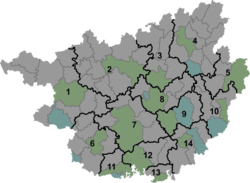Liujiang District
Liujiang
柳江区 · Liujgyangh Gih | |
|---|---|
 | |
| Coordinates: 24°15′25″N 109°20′13″E / 24.257°N 109.337°E[1] | |
| Country | China |
| Autonomous region | Guangxi |
| Prefecture-level city | Liuzhou |
| District seat | Labao (拉堡镇) |
| Area | |
• Total | 2,504 km2 (967 sq mi) |
| Elevation | 110 m (360 ft) |
| Population (2010)[3] | |
• Total | 562,351 |
| • Density | 220/km2 (580/sq mi) |
| Time zone | UTC+8 (China Standard) |
| Postal code | 5451XX |
Liujiang District (simplified Chinese: 柳江区; traditional Chinese: 柳江區; pinyin: Liǔjiāng Qū; Standard Zhuang: Liujgyangh Gih) is under the administration of Liuzhou, Guangxi Zhuang Autonomous Region, China, located on the southwest bank of the Liu River. It covers a land area of 2,504 square kilometres (967 sq mi) and had a population of 562,351 as of 2010[update]. The southernmost county-level division of Liuzhou City, it lies south of Liuzhou's city proper, bordering the prefecture-level cities of Laibin to the south and Hechi to the northwest.
Administrative divisions
[edit]Liujiang consists of 8 towns:[4]
Labao (拉堡镇), Baipeng (百朋镇), Chengtuan (成团镇), Sandu (三都镇), Ligao (里高镇), Jiangde (进德镇), Chuanshan (穿山镇), Shibo (土博镇)
Transportation
[edit]Rail
[edit]Liujiang hominid
[edit]These findings might give some support to the claim that modern humans from Africa arrived at southern China about 100,000 years BP (Zhiren Cave, Chongzuo City: 100,000 years BP;[5][6][7] and the Liujiang hominid: controversially dated at 139,000–111,000 years BP [8]).
Climate
[edit]| Climate data for Liujiang (1991–2020 normals, extremes 1981–present) | |||||||||||||
|---|---|---|---|---|---|---|---|---|---|---|---|---|---|
| Month | Jan | Feb | Mar | Apr | May | Jun | Jul | Aug | Sep | Oct | Nov | Dec | Year |
| Record high °C (°F) | 27.8 (82.0) |
33.2 (91.8) |
34.5 (94.1) |
35.5 (95.9) |
36.4 (97.5) |
36.7 (98.1) |
39 (102) |
38.9 (102.0) |
38.1 (100.6) |
36.3 (97.3) |
33 (91) |
29.9 (85.8) |
39 (102) |
| Mean daily maximum °C (°F) | 14.3 (57.7) |
16.7 (62.1) |
19.6 (67.3) |
25.4 (77.7) |
29.5 (85.1) |
31.5 (88.7) |
33.1 (91.6) |
33.4 (92.1) |
31.8 (89.2) |
27.8 (82.0) |
22.9 (73.2) |
17.3 (63.1) |
25.3 (77.5) |
| Daily mean °C (°F) | 10.6 (51.1) |
12.9 (55.2) |
16.0 (60.8) |
21.4 (70.5) |
25.2 (77.4) |
27.3 (81.1) |
28.5 (83.3) |
28.6 (83.5) |
26.9 (80.4) |
22.8 (73.0) |
17.8 (64.0) |
12.6 (54.7) |
20.9 (69.6) |
| Mean daily minimum °C (°F) | 8.0 (46.4) |
10.2 (50.4) |
13.4 (56.1) |
18.4 (65.1) |
22.0 (71.6) |
24.5 (76.1) |
25.3 (77.5) |
25.2 (77.4) |
23.3 (73.9) |
19.2 (66.6) |
14.4 (57.9) |
9.5 (49.1) |
17.8 (64.0) |
| Record low °C (°F) | −0.5 (31.1) |
0.2 (32.4) |
0.9 (33.6) |
7.8 (46.0) |
12.2 (54.0) |
16.5 (61.7) |
19.5 (67.1) |
20.5 (68.9) |
14.8 (58.6) |
8.1 (46.6) |
3.2 (37.8) |
−1.6 (29.1) |
−1.6 (29.1) |
| Average precipitation mm (inches) | 63.5 (2.50) |
44.2 (1.74) |
98.7 (3.89) |
129.1 (5.08) |
217.9 (8.58) |
339.0 (13.35) |
212.3 (8.36) |
197.4 (7.77) |
82.9 (3.26) |
57.5 (2.26) |
56.7 (2.23) |
44.6 (1.76) |
1,543.8 (60.78) |
| Average precipitation days (≥ 0.1 mm) | 11.6 | 11.7 | 17.1 | 15.5 | 15.6 | 17.7 | 15.4 | 13.6 | 8.5 | 6.4 | 7.7 | 8.1 | 148.9 |
| Average snowy days | 0.2 | 0.1 | 0 | 0 | 0 | 0 | 0 | 0 | 0 | 0 | 0 | 0.1 | 0.4 |
| Average relative humidity (%) | 75 | 76 | 80 | 79 | 78 | 82 | 80 | 79 | 74 | 70 | 71 | 70 | 76 |
| Mean monthly sunshine hours | 58.6 | 50.1 | 46.4 | 77.4 | 116.7 | 121.1 | 176.8 | 180.2 | 174.5 | 160.1 | 127.8 | 107.1 | 1,396.8 |
| Percent possible sunshine | 17 | 16 | 12 | 20 | 28 | 30 | 43 | 45 | 48 | 45 | 39 | 33 | 31 |
| Source: China Meteorological Administration[9][10] | |||||||||||||
References
[edit]- ^ "Liujiang" (Map). Google Maps. Retrieved 2014-07-02.
- ^ Liuzhou City Land Use Plan (2006–20)/《柳州市土地利用总体规划(2006-2020年)》.(in Chinese) Accessed 8 July 2014.
- ^ 《中国2010年人口普查分县资料》 (in Chinese). 中国统计出版社. December 2012. ISBN 978-7-5037-6659-6.
- ^ 2023年统计用区划代码和城乡划分代码:柳江区 (in Simplified Chinese). National Bureau of Statistics of China.
- ^ Liu, W.; Jin, C.-Z.; Zhang, Y.-Q.; Cai, Y.-J.; Xing, S.; Wu, X.-J.; Cheng, H.; Edwards, R. L.; Pan, W.-S.; Qin, D.-G.; An, Z.-S.; Trinkaus, E.; Wu, X.-Z. (25 October 2010). "Human remains from Zhirendong, South China, and modern human emergence in East Asia". Proceedings of the National Academy of Sciences. 107 (45): 19201–19206. Bibcode:2010PNAS..10719201L. doi:10.1073/pnas.1014386107. PMC 2984215. PMID 20974952.
- "Modern humans emerged far earlier than previously thought, fossils from China suggest". ScienceDaily (Press release). October 28, 2010.
- ^ Dennell, Robin (24 November 2010). "Early Homo sapiens in China". Nature. 468 (7323): 512–513. doi:10.1038/468512a. PMID 21107416. S2CID 205060486.
- ^ "Oldest Modern Human Outside of Africa Found". National Geographic News. 25 October 2010. Archived from the original on October 27, 2010.
- ^ Shena, Guanjun; et al. (2002). "U-Series dating of Liujiang hominid site in Guangxi, Southern China". Journal of Human Evolution. 43 (6): 817–829. doi:10.1006/jhev.2002.0601. PMID 12473485.
- ^ 中国气象数据网 – WeatherBk Data (in Simplified Chinese). China Meteorological Administration. Retrieved 28 May 2023.
- ^ "Experience Template" 中国气象数据网 (in Simplified Chinese). China Meteorological Administration. Retrieved 28 May 2023.
External links
[edit]

